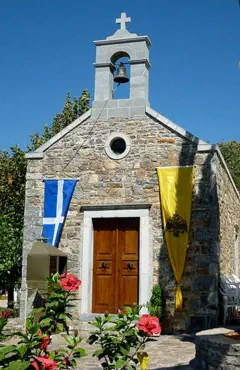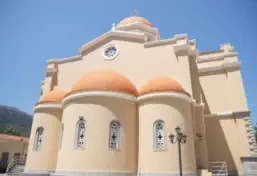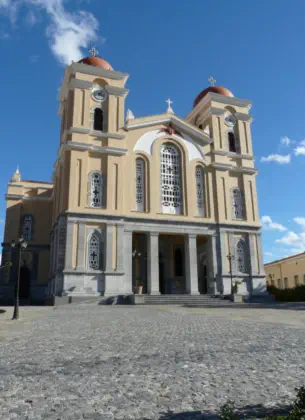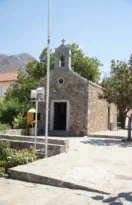The metropolitan church, dedicated to the Dormition of the Theotokos (August 15), rises magnificent
in the north corner of the central square of Neapolis. Its erection at the turn of the 19th to the 20th
century lasted a long time due to the financial constraints of the period. It had been founded in the
year 1889 by bishop Meletios Chlapoutakis, was mostly built by his successor, bishop Titos
Zografides, and was completed by bishop Dionysios Maragoudakis who inaugurated it on
September 27, 1927. The church belongs to the cross-in-square plan with a zenana and two tower-
like belfries on its western side which flank a porch with a tribelon opening. Its lower section is
particularly cared for because most of the structure is built out of carved masonry from grey local
marble as are the openings in their entirety and the voluminous pillars in its interior. The wood-
carved altar screen as well as the iconography in the interior belongs to the period 1962 – 1965 when
the church was renovated extensively because of damage. North of the metropolitan church, a small
barrel-vaulted church of the All-Holy Virgin ‘Fermalina’ dated to the 19th century, has been built on
top of the foundations of an older church.
Aerial photograph of
this magnificent church
clearly
showing the Cruciform
shape.
Photo by MiKe Dialynas

Church of Megali Panagia at Neapolis






The church of Megali Panagia in the central square of Neapolis dominates all
parts of the city, being the largest church in Eastern Crete. It is dedicated to
the Assumption of the Virgin and during its celebration, on August 15, it receives
thousands of pilgrims from all over Crete. It is cruciform inscribed with a dome, a
gyneconite and two imposing tower bell towers to the west. Inside, the marble
surfaces, the wood-carved iconostasis and the modern frescoes of 1962-1965 are
impressive. Outside the church are the tombs of bishops of the region.
The church has been built on the site of the Monastery of the Great Virgin Mary,
which was named after a copy of the icon of the Great Virgin Mary located in
Jerusalem. The monastery of Megali Panagia was founded before the conquest of
Eastern Crete by the Ottomans in 1645 and had under its jurisdiction the
entire New Village, i.e. today's Neapolis . It was a stauropigian monastery, i.e. it
was administered directly by the Ecumenical Patriarch, until 1713, when it was
transferred to the Diocese of Petra.
When all the buildings of the monastery and the catholicon were in ruins during
the 19th century, the inhabitants asked the Turkish authorities to rebuild
them. The bishop of Petra, Joakim Klontzas, received the permission to rebuild
the catholicon of the Virgin and thus in 1819 the small one-room church of
the Great Virgin of Fermalina, which we see today next to the metropolitan
church, was built on the ruins of the old church. The name Mikri Panagia has also
erroneously prevailed, in contrast to the largest metropolitan church, since the
name Megali Panagia pre-existed.
In 1883 the church of Panagia Fermalina was considered to be in a state of
disrepair and permission was requested to build the new metropolitan church of
New Village. Its construction took many years as it was founded in 1889 by
bishop Meletios Chlapoutakis, built mainly during the tenure of bishop Titos
Zografidis and completed in 1927 during the bishopric of Dionysios
Maragoudakis. The temple suffered a lot of damage during the bombings of the
Second World War and was repaired in 1963, when all traces of the old monastery
were demolished.
Situated in the Christian Quarter of the Old City of Jerusalem, the church contains the site where Jesus was crucified, Calvary or
Golgotha, and Jesus’s empty tomb where he was buried and subsequently resurrected. It has been a major pilgrimage destination
for Christians and its original Greek name was Church of the Anastasis (‘Resurrection’).
Tucked away behind the kiosk Karidianakis near the BP garage in Neapoli is a tiny, old church called the Church of the Holy
Sepulchre. It is the only one on Crete, the only one in Greece and possibly the only one in the world outside of Jerusalem.
Renovation work has taken place because after the Occupation of Crete during World War II, a great amount of damage was
caused when a bomb exploded.
Church of the Holy Sepulchre (Panagiou Tafou)
The metropolitan church, dedicated to the Dormition of the
Theotokos (August 15), rises magnificent in the north corner of
the central square of Neapolis. Its erection at the turn of the
19th to the 20th century lasted a long time due to the financial
constraints of the period. It had been founded in the year 1889
by bishop Meletios Chlapoutakis, was mostly built by his
successor, bishop Titos Zografides, and was completed by
bishop Dionysios Maragoudakis who inaugurated it on
September 27, 1927. The church belongs to the cross-in-square
plan with a zenana and two tower-like belfries on its western
side which flank a porch with a tribelon opening. Its lower
section is particularly cared for because most of the structure is
built out of carved masonry from grey local marble as are the
openings in their entirety and the voluminous pillars in its
interior. The wood-carved altar screen as well as the
iconography in the interior belongs to the period 1962 – 1965
when the church was renovated extensively because of
damage. North of the metropolitan church, a small barrel-
vaulted church of the All-Holy Virgin ‘Fermalina’ dated to the
19th century, has been built on top of the foundations of an
older church.
Aerial photograph of this magnificent church
clearly showing the Cruciform shape.
Photo by MiKe Dialynas
The church of Megali Panagia in the central square
of Neapolis dominates all parts of the city, being the largest
church in Eastern Crete. It is dedicated to the Assumption of
the Virgin and during its celebration, on August 15, it
receives thousands of pilgrims from all over Crete. It is
cruciform inscribed with a dome, a gyneconite and two
imposing tower bell towers to the west. Inside, the marble
surfaces, the wood-carved iconostasis and the modern
frescoes of 1962-1965 are impressive. Outside the church are
the tombs of bishops of the region.
The church has been built on the site of the Monastery of the
Great Virgin Mary, which was named after a copy of the icon
of the Great Virgin Mary located in Jerusalem. The monastery
of Megali Panagia was founded before the conquest of
Eastern Crete by the Ottomans in 1645 and had under its
jurisdiction the entire New Village, i.e. today's Neapolis . It
was a stauropigian monastery, i.e. it was administered
directly by the Ecumenical Patriarch, until 1713, when it was
transferred to the Diocese of Petra.
When all the buildings of the monastery and the catholicon
were in ruins during the 19th century, the inhabitants asked
the Turkish authorities to rebuild them. The bishop of
Petra, Joakim Klontzas, received the permission to rebuild the
catholicon of the Virgin and thus in 1819 the small one-room
church of the Great Virgin of Fermalina, which we see today
next to the metropolitan church, was built on the ruins of the
old church. The name Mikri Panagia has also erroneously
prevailed, in contrast to the largest metropolitan church,
since the name Megali Panagia pre-existed.
In 1883 the church of Panagia Fermalina was considered to
be in a state of disrepair and permission was requested to
build the new metropolitan church of New Village. Its
construction took many years as it was founded in 1889 by
bishop Meletios Chlapoutakis, built mainly during the tenure
of bishop Titos Zografidis and completed in 1927 during the
bishopric of Dionysios Maragoudakis. The temple suffered a
lot of damage during the bombings of the Second World War
and was repaired in 1963, when all traces of the old
monastery were demolished.







